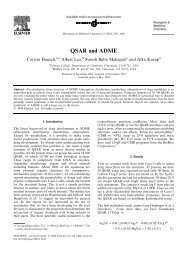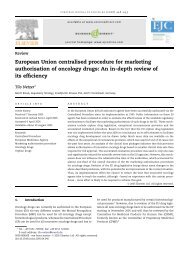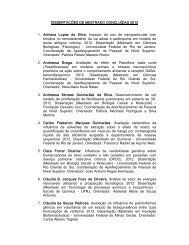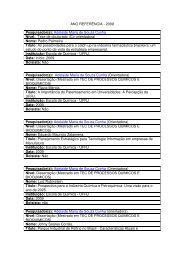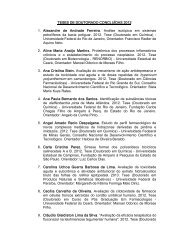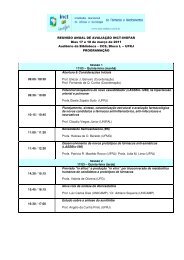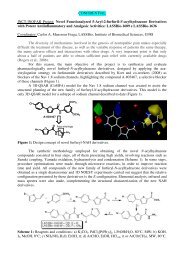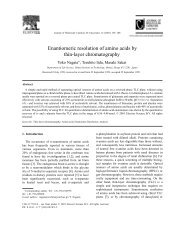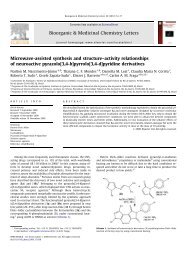4348 Journal of Medicinal Chemistry, 2004, Vol. 47, No. 18 Perspectivematerial required to obtain a 1D carbon spectra in areasonable acquisition time has dropped from more thana hundred milligrams to submilligram quantities overthe past few years. Probe design has gone through ametamorphosis, and a wide selection of probes is nowavailable for various applications. Small-volume probes,such as high-resolution magic angle spinning nanoprobes,95 flow probes for LC NMR (400-100 µL), andcapillary probes (10-25 µL), 96-99 have made a tremendousimpact on metabolite and impurity identificationbecause of their high signal to noise performance. Therecent introduction of cryoprobes promises a further 3-to 4-fold boost in signal to noise ratios. 97,100-102A prelude to the advances in probe design was thedevelopment of solvent suppression pulse sequences. 103Solvent suppression sequences have been automated foreffortless incorporation into any NMR experiment. Thecombination of the gain in sensitivity due to probedesign and the ease of solvent suppression is the maindriver for the improvements in the identification ofsmall quantities of metabolites and in the developmentof methods that couple NMR with other analyticaltechniques such as liquid chromatography (LC/NMR)and mass spectrometry (LC/NMR/MS). 104-109 As a result,LC/NMR in combination with mass spectrometryhas become a major contributor of metabolite identification.Flow or direct injection NMR was introduced in themid 1990s for 96-well plate analyses. Shortly after that,flow-probe NMR technology was integrated with LC andMS as necessitated by the need for structural characterizationof low-level metabolites. This integrationallowed the determination of the exact molecular structureof metabolites in one HPLC injection. To increasethe sensitivity of LC/NMR further, an automated solidphaseextraction has been incorporated into an LCNMR system. 110-112 Recently, with the introduction ofcapillary probes, capillary electrophoresis-NMR is alsobecoming a reality. 98One-dimensional proton LC/NMR often providesenough information about the structure of metabolites.Various 2D NMR experiments can be used to confirmthe structure or for identification of more complexstructure. 92,93In summary, advances in NMR instrumentation andtechniques have made the characterization of metabolitestructures a routine part of the drug discovery anddevelopment process.ConclusionsThe numerous examples discussed above demonstratethat biological transformation can be a useful approachfor discovering drugs. It is therefore useful to screendrug candidates for possible conversion to active metabolitesduring the discovery stage. Active metabolitesmay show superior pharmacology, pharmacokinetics,and safety profiles in comparison to their parent molecules,and the inherent benefits that metabolites oftendisplay make their study a worthwhile endeavor. Asdiscussed above, a number of active metabolites ofmarketed drugs have already been developed as drugsin their own right. Also discussed in this paper areseveral examples where active metabolites were identifiedduring the discovery phase and either became leadcompounds or led to the structural alterations of thechemotype. Consequently, the discovery of drugs throughbiological transformation can be an integral part of thedrug discovery process and it may therefore be beneficialto have a process in place to screen drug candidates insearch of active metabolites.There are a number of experimental observationsduring the preclinical pharmacokinetic and pharmacodynamicevaluations of drug candidates that can triggerthe search for conversion of drug candidates to activemetabolites. Approaches such as the rapid bioassayguided method described herein can be used to generateand detect active metabolites. Different biological methodsare now available for production of active metabolites.Large-scale synthesis of metabolites by biologicalmethods is now feasible because of the recent advancesin biotechnology, particularly in the area of CYP bioreactorsand microbial methods. Recent advances in LC/MS and LC/NMR technologies have also expedited thestructural characterization of metabolites with highsensitivity, specificity, and speed. These advances havemade the routine identification and evaluation of metabolitesa reality.Acknowledgment. We gratefully acknowledge Dr.David Rodrigues for his critical review of this manuscript.BiographiesAberra Fura received his Ph.D. in Chemistry in 1992 fromCornell University. After 2 years of postdoctoral fellowship atthe Department of Chemistry at University of California,Berkeley, he moved to Cytomed inc., a biopharmaceuticalcompany in Cambridge, MA, where he began his career in drugmetabolism, pharmacokinetics, and bioanalytical sciences. Hemoved to Bristol-Myers Squibb, Pharmaceutical ResearchInstitute in 1997, where he is currently a Principal Scientistin the Metabolism and Pharmacokinetics Department. Hisinterest is in the application of drug metabolism and pharmacokineticsto drug discovery, in vitro and in vivo correlations,and LC/MS and new technology in drug metabolism. Heis a co-inventor of several patents in the drug design areabased on biological transformation methods, active metabolites,and structure-metabolism relationship.Yue-Zhong Shu received his Ph.D. degree in PharmaceuticalScience from Toyama Medical and Pharmaceutical University(Japan) in 1988 on the chemistry and biotransformationof bioactive natural products. He went on for postdoctoralappointments at University of Saskatchewan and VirginiaTech on the metabolism and synthesis of central nervoussystem drugs and naturally occurring heterocyclic mutagens.He started his industrial career at the Drug MetabolismDepartment of Pfizer Central Research Division in 1991. Later,he joined Bristol-Myers Squibb, Pharmaceutical ResearchInstitute, where he is currently Associate Director of DiscoveryBiotransformation. His research is centered around the mammalianand microbial metabolism of synthetic and naturalproduct drug candidates through application of bioorganic,biochemical, and bioanalyitcal methods, aiming at addressingpotential safety and efficacy issues related to drug metabolism.Mingshe Zhu received his B.S. degree in Biochemistry andhis M.S. degree in Chemistry. He received his Ph.D. degreein Analytical Toxicology from SUNY at Albany in 1994. Hecompleted 2 years of postdoctoral training in drug metabolismwith Professor Sidney Nelson at the University of Washington.He is currently a Senior Research Investigator at Bristol-Myers Squibb, Pharmaceutical Research Institute and hasbeen involved in the drug metabolism studies to support drugdevelopment and registration. His current main responsibilityis the development and implementation of new technologies
Perspective Journal of Medicinal Chemistry, 2004, Vol. 47, No. 18 4349and approaches in drug metabolism. His research interestsinclude application of LC/MS and radiodetection techniques,development of cell-based P450 bioreactors, metabolic bioactivation,and reaction phenotyping of metabolizing enzymes.Ronald L. Hanson received his Ph.D. in Biochemistry fromthe University of Wisconsin. After 2 years as a PostdoctoralFellow at Harvard Medical School and 7 years as an AssistantProfessor of Biochemistry at Columbia University, he workedfor 8 years at Sandoz Pharmaceuticals in the diabetes drugdiscovery section in East Hanover, NJ. For the past 16 yearshe has worked in process research and development for Bristol-Myers Squibb in New Brunswick, NJ, where he is currently aSenior Principal Scientist. His research is in the area ofbiocatalysis by microbial cells and enzymes.Vikram Roongta received his Ph.D. in Chemistry fromPurdue University, IN, in the area of biomolecular structuredetermination by NMR. He joined University of Minnesota asa Staff Scientist and for the first 4 years managed theChemistry Department NMR Facility and for the following 4years managed the Biochemistry Department NMR Facilityand performed research on solution structures of proteins byNMR. For the past 6 years he has worked in DiscoveryAnalytical Sciences Department supporting drug discovery atBristol Myers Squibb and is currently a Group Leader. Hisresearch is in the area of applications of NMR in smallmoleculestructure determination in drug discovery.W. Griffith Humphreys, Ph.D., is currently AssociateDirector in the Metabolism and Pharmacokinetics Departmentat Bristol-Myers Squibb, Hopewell, NJ. He received hisgraduate training at the University of Virginia in Chemistryand then completed a Postdoctoral Fellowship at VanderbiltUniversity in molecular toxicology. He oversees a groupresponsible for drug metabolism and pharmacokinetic studiesduring the candidate optimization phase of drug discovery. Hisinterests include drug metabolism, predictive metabolism andtoxicology models, in vitro and in vivo correlations, andstrategies for candidate optimization.References(1) Clader, J. W. The Discovery of Ezetimibe: A view from outsidethe receptor. J. Med. Chem. 2004, 47, 1-9.(2) Schmidt, B.; Schieffer, B. Angiotensin II AT1 receptor antagonist.Clinical implications of active metabolites. J. Med. Chem. 2003,46, 2261-2270.(3) Garattini, S. Active drug metabolites: an overview of theirrelevance in clinical pharmacokinetics. Clin. Pharmacokinet.1985, 10, 216-227.(4) Clissold, S. P. Paracetamol and phenacetin. Drugs. 1986, 32(Suppl. 4), 46-59.(5) Flower, R. J.; Moncada, S.; Vane, J. R. Analgesic-antipyreticsand anti-inflammatory agents: drugs employed in the treatmentof gout. In The Pharmacological Basis of Therapeutics, 7th ed.;Gilman, A. G., Goodman, L. S., Rall, T. W., Murad, F., Eds.;Macmillan: New York, 1985; pp 674-715.(6) Baldessarini, R. J. Drugs and the treatment of psychiatricdisorders. In The Pharmacological Basis of Therapeutics, 7thed.; Gilman, A. G., Goodman, L. S., Rall, T. W., Murad, F., Eds.;Macmillan: New York, 1990; pp 383-435.(7) Mattila, M. J.; Paakkari, I. Variations among non-sedatingantihistamines: are there real differences? Eur. J. Clin. Pharmacol.1999, 55, 85-93.(8) Meeves, S. G.; Appajosyula, S. Efficacy and safety profile offexofenadine HCl: a unique therapeutic option in H1-receptorantagonist treatment. J. Allergy Clin. Immunol. 2003, 112, S69-S77.(9) Murdoch, D.; Goa, K. L.; Keam, S. J. Desloratadine: an updateof its efficacy in the management of allergic disorders. Drugs2003, 63, 2051-2077.(10) Shet, M. S.; McPhaul, M.; Fisher, C. W.; Stallings, N. R.;Estabrook, R. W. Metabolism of the antiandrogenic drug (Flutamide)by human CYP1A2. Drug Metab. Dispos. 1997, 25, 1298-1303.(11) Anderson, R. J.; Kudlacek, P. E.; Clemens, D. L. Sulfation ofminoxidil by multiple human cytosolic sulfotransferases. Chem.-Biol. Interact. 1998, 109, 53-67.(12) Fisher, M. B.; Paine, M. F.; Strelevitz, T. J.; Wrighton, S. A.The role of hepatic and extrahepatic UDP-glucuronosyltransferasesin human drug metabolism. Drug Metab. Rev. 2001, 33,273-279.(13) Baillie, T. A.; Cayen, M. N.; Fouda, H.; Gerson, R. J.; Green, J.D.; Grossman, S. J.; Klunk, L. J.; LeBlanc, B.; Perkins, D. G.;Shipley, L. A. Drug metabolites in safety testing. Toxicol. Appl.Pharmacol. 2002, 182, 188-196.(14) Hastings, K. L.; El-Hage, J.; Jacobs, A.; Leighton, J.; Morse, D.;Osterberg, R. E.; Letter to the editor. Toxicol. Appl. Pharmacol.2003, 190, 91-92.(15) White, R. E. High-throughput screening in drug metabolism andpharmacokinetic support of drug discovery. Annu. Rev. Pharmacol.Toxicol. 2000, 40, 133-157.(16) Fura, A.; Lounsbury, H.; Yu, S.; Cai, X.; Yaeger, D.; Scannell,R.; Libertine, G. L.; Grewal, G.; Hussoin, S.; Killian, D. B.;Young, M.; Zuo, F.; Ellis, J.; Fisher, R.; Yeh, G. Structureactivityrelationships and rate of glucuronidation of CMI-977and its analogs. Pharm. Res. 1997, 14, (Suppl. 11), 552.(17) White, R. E. Short- and long-term projections about the use ofdrug metabolism in drug discovery and development. Drug.Metab. Dispos. 1998, 26, 1213-1216.(18) Rosenblum, S. B.; Huynh, T.; Afonso, A.; Davis, H. R., Jr.;Yumibe, N.; Clader, J. W.; Burnett, D. A. Discovery of 1-(4-Fluorophenyl)-(3R)-[3-(4-fluorophenyl)-(3S)-hydroxypropyl]-(4S)-(4-hydroxyphenyl)-2-azetidinone (SCH 58235): a designed, potent,orally active inhibitor of cholesterol absorption. J. Med.Chem. 1998, 41, 973-980.(19) Yumibe, N.; Huie, K.; Chen, K. J.; Snow, M.; Clement, R. P.;Cayen, M. N. Identification of human liver cytochrome P450enzymes that metabolize the nonsedating antihistamine loratadine:formation of descarboethoxyloaratadine by CYP3A4 andCYP2D6. Biochem. Pharmacol. 1996, 51, 165-172.(20) Norman, P.; Dihlmann, A.; Rabasseda, X. Desloratadine: Apreclinical and clinical overview. Drugs Today. 2001, 37, 215-227.(21) Hibert, J.; Radwanski, E.; Weglein, R.; Lue, V.; Prerentesis, G.;Symchowicz, S. Pharmacokinetics and dose proportionality ofloratadine. J. Clin. Pharmacol. 1987, 27, 694-698(22) Radwasnki, E.; Hilbert, J.; Symchowicz, S.; Zampaglione, N.Loratadine: Multiple dose pharmacokinetics. J. Clin. Pharmacol.1987, 27, 530-533.(23) Osborne, R.; Thompson, P.; Joel, S.; Trew, D.; Patel, N.; Slevin,M. The analgesic activity of morphine 6-glucuronide. Br. J. Clin.Pharmacol. 1992, 34, 130-138.(24) Ritter, J. K. Roles of glucuronidation and UDP-glucuronosyltransferasesin xenobiotic bioactivation reactions. Chem.-Biol.Interact. 2000, 129, 171-193.(25) Portenoy, R. K.; Khan, E.; Layman, M.; Lapin, J.; Malkin, M.G.; Foley, K. M.; Thaler, H. T.; Cerbone, D. J.; Inturrisi, C. E.Chronic morphine therapy for cancer pain: plasma and cerebrospinalfluid morphine and morphine-6-glucuronide concentrations.Neurology 1991, 41, 1527-1461.(26) Benedetti, M. S.; Plisnier, M.; Kaise, J.; Maier, L.; Baltes, E.;Arendt, C.; McCracken, N. Absorption, distribution, metabolismand excretion of [ 14 C]levocetirizine, the R enantiomer of cetirizine,in healthy volunteers. Eur. J. Clin. Pharmacol. 2001, 57,571-582.(27) Yun, C. H.; Okerholm, R. A.; Guengerich, F. P. Oxidation of theantihistaminic drug terfenadine in human liver microsomes.Role of cytochrome P-450 3A(4) in N-dealkylation and C-hydroxylation. Drug Metab. Dispos. 1993, 21, 403-409.(28) Woosley, R. L.; Chen, Y.; Freiman, J. P.; Gillis, R. A. Mechanismof the cardiotoxic actions of terfenadine. JAMA, J. Am. Med.Assoc. 1993, 269, 1532-1536.(29) Crumb, W. J.; Wible, B.; Arnold, D. J.; Payne, J. P.; Brown, A.M. Blockade of multiple human cardiac potassium currents bythe antihistamine terfenadine: possible mechanism for terfenadine-associatedcardiotoxicity. Mol. Pharmacol. 1995, 47, 181-190.(30) Honig, P. K.; Wortham, D. C.; Zamani, K.; Conner, D. P.; Mullin,J. C.; Cantilena, L. R. Terfenadine-ketoconazole interaction.Pharmacokinetic and electrocardiographic consequences. JAMA,J. Am. Med. Assoc. 1993, 269, 1513-1518.(31) Jensen, C. B.; Jollow, D. J. The role of N-hydroxyphenetidine inphenacetin-induced hemolytic anemia. Toxicol. Appl. Pharmacol.1991, 111, 1-12.(32) Gonzalez, F. J. The molecular biology of cytochrome P450s.Pharmacol. Rev. 1988, 40, 243-288.(33) Van Heek, M.; France, C. F.; Compton, D. S.; McLeod, R. L.;Yumibe, N. P.; Alton, K. B.; Sybertz, E. J.; Davis, H. R., Jr. Invivo metabolism-based discovery of a potent cholesterol absorptioninhibitor, SCH 58235, in the rat and rhesus monkey throughidentification of the active metabolites of SCH 48461. J. Pharmacol.Exp. Ther. 1997, 283, 157-163.(34) Khanna, A.; Humphreys, W. G.; Parker, R.; Hamann, L.Unpublished work.(35) Fura, A.; Vyas, V.; Harper, T.; Shyu, W. C.; Zhu, M.; Salvati,M.; Attar, R.; Humphreys, W. G. Drug Metab. Rev. 2002, 34(Suppl. 1), 135.



